Social Housing and Affordable Rent: The Effectiveness of Legal Thresholds of Rents in Two Italian Metropolitan Cities
Abstract
:1. Introduction
2. Social Housing in the European Union and United Kingdom
3. Housing Issue in Italy
3.1. Rules of Law and Funding of Social Housing
- low-income households, including single-parent or single-income households;
- young low-income couples;
- elderly people in socially or economically disadvantaged conditions;
- commuter students;
- households subjected to eviction;
- other households (according to articolo 1, legge n. 9, 8 febbraio 2007); and
- low-income legal immigrants who have resided in the country for at least ten years or at least five years in the same region.
3.2. Territorial Asymmetries of Social Housing
- one at an inter-regional level among people living in cities where there is an existing/absent SH offer; and
- one at an intra-urban or metropolitan level among the inhabitants of cities where there is an SH offer, as not all eligible persons are able to access SH due to the scarcity of supply.
- the first is the absolute housing emergency which concerns individuals in absolute poverty (4.6 million people and 1.6 million households in 2019) who do not have the resources to live adequately. These people would be entitled to public housing;
- the second is the housing discomfort of those who are in relational poverty (8.8 million individuals and 2.9 million households in 2016) as, despite having a low to medium income, they cannot find adequate housing for their needs in the housing market. These people may require SH housing (Figure 6) [29].
- economic factors concerning income level or the need to relocate for work;
- social factors concerning the changing composition of families, particularly as the number of single-person and single-parent families has increased in recent years due to an increasing number of separations/divorces and elderly lonely people. In addition, young people find it difficult to move on their own due to the absence of stable and well-paying jobs;
- demographic factors related to the high percentage of foreigners in precarious employment.
3.3. Eligibility of Householders for Social Housing
- list of the eligible categories (elderly, young couples, single-income households, etc.);
- income limits of the applicant (usually the total income of the members of the household with some detractions);
- characteristics and dimensions of the housing in relation to the number of the household members and, sometimes, description of spaces serving the housing (common areas, gardens, parking, etc.);
- conditions of leases, leases with covenants of future sale or sale of SH units (duration of the lease, payment of deposits, etc.);
- rents, lease with future sale covenants or sale prices of housing, determined in relation to regional as well as national legislation, and thresholds that such rents may not exceed; and
- criteria for the formation of rankings of beneficiaries.
3.4. The Agreed Rents as Threshold Benchmarked Rents
4. Materials: The Metropolitan Cities of Milan and Bari (Italy)
5. Methods
5.1. General
- Construction of a database with data from municipalities and local agreements, such as characteristics of municipalities, agreed rents by municipality, zone, and sub-zone;
- Segmentation of the housing market through cluster analysis;
- Analysis of the internal coherence of the agreed rents by the semantic categories of differentiation of the attractiveness of MACBETH (Measuring Attractiveness by a Categorical-Based Evaluation Technique);
- Comparison of agreed rents with OMI rents.
5.2. Database
5.3. Segmentation of the Housing Market
5.3.1. Cluster Analysis
5.3.2. K-Medoid Algorithm Cluster Validation
- 0.71 to 1.00: a strong structure has been found;
- 0.51 to 0.70: a reasonable structure has been found;
- 0.26 to 0.50: the structure is weak and could be artificial. Try other methods on this database;
- −1 to 0.25: no substantial structure has been found.
5.4. Analysis of the Internal Coherence of the Agreed Rents
5.5. Analysis of the External Coherence of the Agreed Rents
6. Application and Results
6.1. Rental Local Agreement Survey
- sub-zone 1: (a) if only one of type A elements is missing or if cadastral type A/5 is missing; (b) if, equipped with heating system, also by stoves in the individual rooms, except for buildings that have at least four type B elements; (c) if housing units have less than three Type B elements, but all Type A elements.
- sub-zone 2: (a) if housing units have all the elements of type A and at least three elements of type B; (b) if they have all the minimum elements of type A and B, required for sub-zone 2, and less than three elements of type C.
- sub-zone 3: if housing units have all the elements of type A, at least three elements of type B and three elements of type C and in any case cannot be placed in this sub-zone the buildings if of cadastral type A/3 (of class 1, 2, 3), A/4 and A/6.
6.2. Coherence Analysis of the Agreed Rents Based on the k-Medoids Clustering
6.2.1. Results for the Metropolitan City of Milan
- (agreed rents 1–72; 74–75; 77–269) with centroid in agreed rent 14;
- (agreed rent 73) with centroid in agreed rent 73;
- (agreed rent 76) with centroid in agreed rent 76.
- Centroid 1: annual rent of €70 per square meter; minimum real estate features score 5; accessibility score 4; population density 2801.91; population with income 15,000–26,000 as 35%, municipality: Bollate; sub-zone 2;
- Centroid 2: annual rent of €44 per square meter; minimum real estate features score 1; accessibility score 3; population density 3412.67; population with income 15,000–26,000 as 32%. municipality: Legnano-semi-central; sub-zone 1.
- Centroid 3: annual rent of €35 per square meter; minimum real estate features score 1; accessibility score 3; population density 3412.67; population with income 15,000–26,000 as 32%. Municipality: Legnano-suburb; sub-zone 1.
6.2.2. Results for the Metropolitan City of Bari
- (agreed rent 4) with centroid in agreed rent 4;
- (agreed rents 1–3, 5–35, 37–45) with centroid in agreed rent 16;
- (agreed rent 36) with centroid in agreed rent 3.
- Centroid 1: annual rent of €26.04 per square meter; minimum real estate features score 5; accessibility score 4; population density 312.65; population with income 15,000–26,000 as 26%, municipality: Adelfia; sub-zone 1.
- Centroid 2: annual rent of €22.32 per square meter; minimum real estate features score 4; accessibility score 3; population density 498.96; population with income 15,000–26,000 as 25%, municipality: Bitonto; sub-zone 3.
- Centroid 3: annual rent of €14.28 per square meter; minimum real estate features score 3; accessibility score 3; population density 643.44; population with income 15,000–26,000 as 23%, municipality: Noicottaro; sub-zone 1.
6.3. External Coherence of the Agreed Rents
7. Discussion
7.1. Coherence of the Agreed Rents in Two Metropolitan Cities Based on the Semantic Categories of MACBETH
7.1.1. Coherence of the Agreed Rents in the Metropolitan City of Milan
7.1.2. Coherence of the Agreed Rents in the Metropolitan City of Bari
7.2. Comparison of the Coherence of the Agreed Rents in the Two Metropolitan Cities
8. Conclusions
Author Contributions
Funding
Acknowledgments
Conflicts of Interest
Appendix A
| Typology of Distance | Municipalities in the Metropolitan City of Milan |
|---|---|
| Very strong | Arese 1–2; Basiglio-Milano 3; Basiglio-Historic centre; Legnano-Central |
| Strong | Busto Garolfo; Canegrate; Cerro Maggiore; Dairago; Lainate 1–2; Locate di Triulzi; Nerviano; Milano-Microzone: C02, C03, C05, C09, C10, C11; Milano-Microzone: C01, C06, C07, C08, C12, D09, D11, D12, D14, D29; Milano-Microzone:D10, D13, D15, D23, D28; Milano-Microzone: D07, D08, D16, D24, D27; Milano-Microzone: D02, D04, D05, D06, D17, D18, D19, D20, D21, D22, D25; Milano-Microzone: D01, D26, E01, E02, E03; Milano-Microzona:D03; Opera-Residential; Opera-Industrial; Opera-Agricultural; Rescaldina; Rozzano-Aler; Rozzano 1–2; San Giorgio; San Vittore Olona, Segrate; Settimo milanese 1–2; Solaro; Villa Cortese; Vimodrone |
| Moderate | Cornaredo 1–2; Milano-Microzone: A01-A04, B01, B02; Milano-Microzone: B03, B05, B06, C04; Milano-Maggiolina; Milano-Caprilli San Siro; Segrate 1–4; Vimodrone |
| Weak | Bollate-centre; Bollate-Cassina nuova; Bollate-Cascina del sole; Bresso 1–2; Cinisello Balsamo-Historic centre; Cinisello Balsamo-San Eusebi; Cinisello Balsamo-Crocetta; Cinisello Balsamo; Garbagnate Milanese-Central; Garbagnate Milanese-Semi-central; Garbagnate Milanese-Suburbs; Garbagnate Milanese-Suburbs; Paderno Dugnano; Parabiago-Centre and Ravello; Parabiago-Hamlets, suburbs; Pero-Centre; Pero; Pieve Emanuele-Residential, Pieve Emanuele-Residential; Pieve Emanuele-Agricultural; Pieve Emanuele-Agricultural; Pioltello- Limito, Pioltello-Satellite district and Piazza Garibaldi; Pioltello- Industrial and agricultural; Pogliano; Pregnana Milanese; Rho 1–3; Senago-Centre; Senago-Suburbs; Sesto-Marelli; Sesto-Piazza Garibaldi; Sesto-Pelucca; Cascina Gatti; Parpagliona; Vanzago |
| Very weak | Novate Milanese; Pieve Emanuele-Tolcinasco; Pioltello-San Felice; Pioltello-Nuova Seggiano |
Appendix B
| Typology of Distance | Municipalities in the Metropolitan City of Milan |
|---|---|
| Very strong | Arese 1–2; Basiglio-Milano 3; Legnano-Central; Legnano-Semi-central; Legnano-Suburbs |
| Strong | |
| Moderate | |
| Weak | Busto Garolfo; Canegrate; Cerro Maggiore; Cornaredo; Dairago; Lainate 1–2, Locate di Triulzi; Nerviano; Milano-Microzone: A01-A04, B01, B02; Milano-Microzone: B03, B05, B06, C04; Milano-Microzone: C02, C03, C05, C09, C10, C11; Milano-Microzone: C01, C06, C07, C08, C12, D09, D11, D12, D14, D29; Milano-Microzone: D10, D13, D15, D23, D28; Milano-Microzone: D07, D08, D16, D24, D27, Milano-Microzone: D02, D04, D05, D06, D17, D18, D19, D20, D21, D22, D25; Milano-Microzone: D01, D26, E01, E02, E03; Milano-Microzona: D03; Milano-City Life Porta Nuova; Milano-Maggiolina; Milano-Caprilli San Siro; Opera-Residential; Opera-Industrial; Opera-Agricultural; Rescaldina; Rozzano-Aler; Rozzano-Ponte Sesto; Cassino; Rozzano historic centre; Vallembrosia; Rozzano-Quinto de’ Stampi; San Giorgio; San Vittore Olona; Segrate 1–5; Settimo milanese 1–2; Solaro; Villa Cortese; Vimodrone 1–2 |
| Very weak | Basiglio-historic centre; Bollate-centre; Bollate-Cassina nuova; Bollate-Cascina del sole; Bresso 1–2; Cinisello Balsamo-historic centre; Cinisello Balsamo-San Eusebio; Cinisello Balsamo-Crocetta; Cinisello Balsamo; Cornaredo; Garbagnate Milanese-Central; Garbagnate Milanese-Semi-centra; Garbagnate Milanese-Suburbs 1–2; Novate Milanese; Paderno Dugnano; Parabiago-Central and Ravello; Parabiago-suburbs; Pero-Central; Pero; Pieve Emanuele-Residential 1–2; Pieve Emanuele-Tolcinasco; Pieve Emanuele-Agricultural 1–2; Pioltello-San Felice; Pioltello-Nuova Seggiano; Pioltello-Limito; Pioltello-Satellite district and Piazza Garibaldi; Pioltello-Industrial and agricultural; Pogliano; Pregnana Milanese; Rho 1–3; Senago-Centre; Senago-Suburbs; Sesto-Marelli; Sesto-Rondinella, Rondò, Station; Sesto-Pelucca, Cascina, Gatti, Parpagliona, Sesto-Torretta; Vanzago |
Appendix C
| Typology of Distance | Municipalities in the Metropolitan City of Milan |
|---|---|
| Very strong | |
| Strong | Arese 1–2; Basiglio-Milano 3; Basiglio-Historic centre; Legnano-Central; Legnano-Semi-central; Legnano-Suburbs |
| Moderate | |
| Weak | Busto Garolfo; Canegrate; Cerro Maggiore; Dairago; Lainate 1–2; Locate di Triulzi; Nerviano; Milano-Microzone: A01-A04, B01, B02; Milano-Microzone: B03, B05, B06, C04; Milano-Microzone: C02, C03, C05, C09, C10, C11; Milano-Microzone: C01, C06, C07, C08, C12, D09, D11, D12, D14, D29; Milano-Microzone: D10, D13, D15, D23, D28;, Milano-Microzone: D07, D08, D16, D24, D27; Milano-Microzone: D02, D04, D05, D06, D17, D18, D19, D20, D21, D22, D25; Milano-Microzone: D01, D26, E01, E02, E03; Milano-Microzona: D03; Milano-City Life Porta Nuova; Milano-Maggiolina; Milano-Caprilli San Siro; Opera-Residential; Opera-Industrial; Opera-Agricultural; Rescaldina; Rozzano-Aler; Rozzano-Ponte Sesto, Cassino; Rozzano-Vecchia, Vallembrosia, Rozzano; San Giorgio; San Vittore Olona; Segrate 1–5; Settimo milanese 1–2; Solaro, Vanzago; Villa Cortese; Vimodrone 1–2 |
| Very weak | Bollate-Centre; Bollate-Cassina nuova; Bollate-Cascina del sole; Bresso 1–2; Cinisello Balsamo- historic centre; Cinisello Balsamo-San Eusebio; Cinisello Balsamo-Crocetta; Cinisello Balsamo; Cornaredo 1–2; Garbagnate Milanese-Central; Garbagnate Milanese-Semi-central; Garbagnate Milanese-Suburbs; Garbagnate Milanese-Suburbs; Novate Milanese; Paderno Dugnano; Parabiago-Central and Ravello; Parabiago- suburbs; Pero-Central; Pero; Pieve Emanuele-Residential; Pieve Emanuele-Residential; Pieve Emanuele-Tolcinasco; Pieve Emanuele-Agricultural 1–2; Pioltello-San Felice; Pioltello-Nuova Seggiano; Pioltello-Limito; Pioltello-Satellite district and Piazza Garibaldi; Pioltello-Industrial and agricultural, Pogliano; Pregnana Milanese; Rho 1–3; Senago-Centre, Senago-Suburbs; Sesto-Marelli; Sesto-Rondinella, Rondò, Station; Sesto-Pelucca, Cascina Gatti, Parpagliona; Sesto-Torretta |
References
- Marcuse, P. Whose right(s) to what city? In Cities for People, Not for Profit: Critical Urban Theory and the Right to the City, 1st ed.; Brenner, N., Marcuse, P., Mayer, M., Eds.; Routledge: London, UK, 2012; pp. 24–41. [Google Scholar]
- Aalbers, M.; Gibb, K. Housing and the right to the city: Introduction to the special issue. Int. J. Hous. Policy 2014, 14, 207–213. [Google Scholar] [CrossRef]
- Disney, R.; Luo, G. The Right to Buy public housing in Britain: A welfare analysis. J. Hous. Econ. 2017, 35, 51–68. [Google Scholar] [CrossRef]
- Napoli, G.; Giuffrida, S.; Trovato, M.R. Fair Planning and Affordability Housing in Urban Policy. The Case of Syracuse (Italy). In International Conference on Computational Science and Its Applications; Springer: Cham, Switzerland, 2016; pp. 46–62. [Google Scholar] [CrossRef]
- Bottero, M.; Ambrosini, G.; Callegari, G. Valuing the Impact of Social Housing Renovation Programs: An Application of the Social Return on Investment (SROI). In Appraisal: From Theory to Practice; Springer: Cham, Switzerland, 2016; pp. 291–302. [Google Scholar] [CrossRef]
- Marta, B.; Giulia, D. Addressing Social Sustainability in Urban Regeneration Processes. An Application of the Social Multi-Criteria Evaluation. Sustainability 2020, 12, 7579. [Google Scholar] [CrossRef]
- Desvallées, L. Low-carbon retrofits in social housing: Energy efficiency, multidimensional energy poverty, and domestic comfort strategies in southern Europe. Energy Res. Soc. Sci. 2021, 85, 102413. [Google Scholar] [CrossRef]
- Vakalis, D.; Patino, E.D.L.; Opher, T.; Touchie, M.; Burrows, K.; MacLean, H.; Siegel, J. Quantifying thermal comfort and carbon savings from energy-retrofits in social housing. Energy Build. 2021, 241, 110950. [Google Scholar] [CrossRef]
- Saiu, V. Evaluating Outwards Regeneration Effects (OREs) in Neighborhood-Based Projects: A Reversal of Perspective and the Proposal for a New Tool. Sustainability 2020, 12, 10559. [Google Scholar] [CrossRef]
- Al Mulhim, K.A.M.; Swapan, M.S.H.; Khan, S. Critical Junctures in Sustainable Social Housing Policy Development in Saudi Arabia: A Review. Sustainability 2022, 14, 2979. [Google Scholar] [CrossRef]
- Odoyi, E.J.; Riekkinen, K. Housing Policy: An Analysis of Public Housing Policy Strategies for Low-Income Earners in Nigeria. Sustainability 2022, 14, 2258. [Google Scholar] [CrossRef]
- Alqahtany, A. Affordable housing in Saudi Arabia’s vision 2030: New developments and new challenges. Int. J. Hous. Mark. Anal. 2020, 14, 243–256. [Google Scholar] [CrossRef]
- Guarini, M.R.; Battisti, F. A Model to Assess the Feasibility of Public–Private Partnership for Social Housing. Buildings 2017, 7, 44. [Google Scholar] [CrossRef]
- Napoli, G.; Trovato, M.R.; Giuffrida, S. Housing Affordability and Income-threshold in Social Housing Policy. Procedia-Soc. Behav. Sci. 2016, 223, 181–186. [Google Scholar] [CrossRef]
- Napoli, G. The economic sustainability of residential location and social housing. An application in Palermo city. Aestimum 2016, 257–277. [Google Scholar] [CrossRef]
- Della Spina, L.; Calabrò, F.; Rugolo, A. Social Housing: An Appraisal Model of the Economic Benefits in Urban Regeneration Programs. Sustainability 2020, 12, 609. [Google Scholar] [CrossRef]
- Berto, R.; Cechet, G.; Stival, C.A.; Rosato, P. Affordable Housing vs. Urban Land Rent in Widespread Settlement Areas. Sustainability 2020, 12, 3129. [Google Scholar] [CrossRef]
- Stone, M. , Burke, T., Ralston, L. The Residual Income Approach to Housing Affordability: The Theory and the Practice, 1st ed.; AHURI Positioning Paper No. 139; AHURI: Melbourne, Australia, 2011; pp. 44–61. [Google Scholar]
- Napoli, G. Housing Affordability in Metropolitan Areas. The Application of a Combination of the Ratio Income and Residual Income Approaches to Two Case Studies in Sicily, Italy. Buildings 2017, 7, 95. [Google Scholar] [CrossRef]
- Osservatorio del Mercato Immobiliare—OMI. Real Estate Prices. Available online: https://www.agenziaentrate.gov.it/portale/schede/fabbricatiterreni/omi/banche-dati/quotazioni-immobiliari (accessed on 26 September 2020).
- Housing Europe. State of Housing in the 2019. Available online: https://www.housingeurope.eu (accessed on 26 September 2020).
- Eurostat. Income and living conditions. Available online: https://ec.europa.eu/eurostat/web/income-and-living-conditions/data/database (accessed on 26 September 2020).
- Nomisma. La Condizione Abitativa in Italia. Dalle Esperienze di Housing Sociale Alla Risposta del Piano Nazionale di Edilizia Abitativa e del Piano Casa. 2010. Available online: https://www.nomisma.it/la-condizione-abitativa-in-italia (accessed on 26 September 2020).
- Battaglia, R. Housing Sociale: Così la Cassa Depositi e Prestiti Risponde All’emergenza Casa. In Bolle, Crisi, Speculazione: Il Mattone Scricchiola. 2020. Available online: https://valori.it/dossier/gennaio2020 (accessed on 26 September 2020).
- Susanna, A. L’Housing Sociale Come Opportunità di Trasformazione Urbana e Sociale. In Proceedings of the Il Valore Sociale Degli Interventi di Social Housing: Il Progetto di Riqualificazione Urbana Della Ex-Manifattura Tabacchi di Perugia, Torino, Italy, 6 October 2016. [Google Scholar]
- Carriero, A.; Antellini Russo, F.; Screpanti, S.; Alterio, D. Social Housing. Il mercato immobiliare in Italia: Focus sull’edilizia sociale, CDP—Cassa Depositi e Prestiti. 2014. Available online: https://www.cdp.it/resources/cms/documents/3524753ef427665f31b668b176f7c5bf.pdf (accessed on 26 September 2020).
- CDP Investimenti SGR. Housing Sociale. Stato Attuale in Italia e Nei Principali Paesi Europei. 2017. Available online: http://www.unioneinquilini.it/public/doc/cassa_depositi_e_prestiti_dati_su_social_housing_in_italia_e_in_europa.pdf (accessed on 22 July 2020).
- Banca d’Italia. Survey on the Budgets of Italian Households. Available online: https://www.bancaditalia.it/pubblicazioni/indagine-famiglie/bil-fam2016/Statistiche_IBF_20180312.pdf (accessed on 26 September 2020).
- Istituto Nazionale di Statistica—ISTAT. Le Statistiche Dell’istat Sulla Povertà—Anno 2019. Available online: https://www.istat.it/it/files/2020/06/REPORT_POVERTA_2019.pdf (accessed on 26 September 2020).
- ISTAT. Available online: http://dati.istat.it/Index.aspx (accessed on 20 July 2020).
- Gazzetta Ufficiale. Italian and Regional Laws and Regulations on Social Housing. Available online: www.gazzettaufficiale.it (accessed on 26 September 2020).
- Bari Social Housing, Avviso per la Selezione di Candidature per Assegnazione di Alloggi in Locazione e Vendita Convenzionata. Available online: http://barisocialhousing.it/wp-content/uploads/2019/06/Avviso-di-selezione_BSH.pdf (accessed on 8 May 2022).
- Mila Census. Summarised Census Data. Available online: www.ottomilacensus.istat.it (accessed on 26 September 2020).
- Tuttitalia. Data on Italian Municipalities. Available online: www.tuttitalia.it (accessed on 26 September 2020).
- Presidenza del Consiglio dei Ministri. Dipartimento per Gli Affari Regionali e le Autonomie. I Dossier Delle Città Metropolitane. Città Metropolitana di Milano. 2017. Available online: http://www.affariregionali.it/media/170177/dossier-citt%C3%A0-metropolitana-di-milano.pdf (accessed on 26 September 2020).
- Presidenza del Consiglio dei Ministri. Dipartimento per Gli Affari Regionali e le Autonomie. I Dossier Delle Città Metropolitane. Città Metropolitana di Bari. 2017. Available online: http://www.affariregionali.it/media/170173/dossier-citt%C3%A0-metropolitana-di-bari.pdf (accessed on 26 September 2020).
- Sunia. Local Agreements. Available online: https://www.sunia.it/accordi-territoriali (accessed on 26 September 2020).
- Grigsby, W.G. Housing Market and Public Policy; Philadelphia University of Pennsylvania Press: Pennsylvania, PA, USA, 1963. [Google Scholar]
- Allen, M.T.; Springer, T.M.; Waller, N.G. Implicit pricing across residential rental submarkets. J. Real Estate Financ. Econ. 1995, 11, 137–151. [Google Scholar] [CrossRef]
- Goodman, A.C.; Thibodeau, T.G. Housing market segmentation and hedonic prediction accuracy. J. Hous. Econ. 2003, 12, 181–201. [Google Scholar] [CrossRef]
- Jasińska, E.; Preweda, E. The application of factorial analysis in the classification of the attributes of real estates. Gepdezja 2005, 11, 203–212. [Google Scholar]
- Abraham, J.M.; Goetzmann, W.N.; Wachter, S.M. Homogeneous Groupings of Metropolitan Housing Markets. J. Hous. Econ. 1994, 3, 186–206. [Google Scholar] [CrossRef]
- Bourassa, S.C.; Hamelink, F.; Hoesli, M.; Macgregor, B.D. Defining housing market. J. Hous. Econ. 1999, 8, 160–183. [Google Scholar] [CrossRef]
- Basu, S.; Thibodeau, T.G. Analysis of Spatial Autocorrelation in House Prices. J. Real Estate Financ. Econ. 1998, 17, 61–85. [Google Scholar] [CrossRef]
- Goodman, A.C.; Thibodeau, T.G. The Spatial Proximity of Metropolitan Area Housing Submarkets. Real Estate Econ. 2007, 35, 209–232. [Google Scholar] [CrossRef]
- Hwang, S.; Thill, J.C. Delineating Urban Housing Submarkets with Fuzzy Clustering. Environ. Plan. B Plan. Des. 2009, 36, 865–882. [Google Scholar] [CrossRef]
- Hruschka, H. Market definition and segmentation using fuzzy clustering methods. Int. J. Res. Mark. 1986, 3, 117–134. [Google Scholar] [CrossRef]
- Gan, G.; Ma, C.; Wu, J. Data Clustering: Theory, Algorithms, and Applications. In ASA-SIAM Series on Statistics and Applied Mathematics; Society for Industrial and Applied Mathematics: Philadelphia, PA, USA, 2007. [Google Scholar] [CrossRef]
- Kaufman, L.; Rousseeuw, P.J. Partitioning Around Medoids (Program PAM). In Finding Groups in Data: An Introduction to Cluster Analysis; John Wiley & Sons, Inc.: New York, NY, USA, 1990. [Google Scholar]
- Bana e Costa, C.A.; De Corte, J.-M.; Vansnick, J.-C. On the Mathematical Foundation of MACBETH. In Multiple Criteria Decision Analysis: State of the Art Surveys; Springer: New York, NY, USA, 2005; pp. 409–437. ISBN 978-0-387-23067-2. [Google Scholar] [CrossRef]
- Trovato, M.R.; Clienti, C.; Giuffrida, S. People and the City: Urban Fragility and the Real Estate-Scape in a Neighborhood of Catania, Italy. Sustainability 2020, 12, 5409. [Google Scholar] [CrossRef]
- Gabrielli, L.; Giuffrida, S.; Trovato, M.R. Gaps and Overlaps of Urban Housing Sub-market: Hard Clustering and Fuzzy Clustering Approaches. In Appraisal: From Theory to Practice; Springer: Cham, Switzerland, 2016; pp. 203–219. [Google Scholar] [CrossRef]
- Gabrielli, L.; Giuffrida, S.; Trovato, M.R. From Surface to Core: A Multi-Layer Approach for the Real Estate Market Analysis of a Central Area in Catania; ICCSA 2015, LCNS 9157; Gervasi, O., Murgante, B., Misra, S., Eds.; Springer: London, UK, 2015; Volume III, pp. 284–300. [Google Scholar] [CrossRef]
- Napoli, G.; Giuffrida, S.; Valenti, A. Forms and Functions of the Real Estate Market of Palermo (Italy). Science and Knowledge in the Cluster Analysis Approach. In Appraisal: From Theory to Practice; Stanghellini, S., Morano, P., Bottero, M., Oppio, A., Eds.; Springer: Cham, Switzerland, 2016; pp. 191–202. [Google Scholar] [CrossRef]


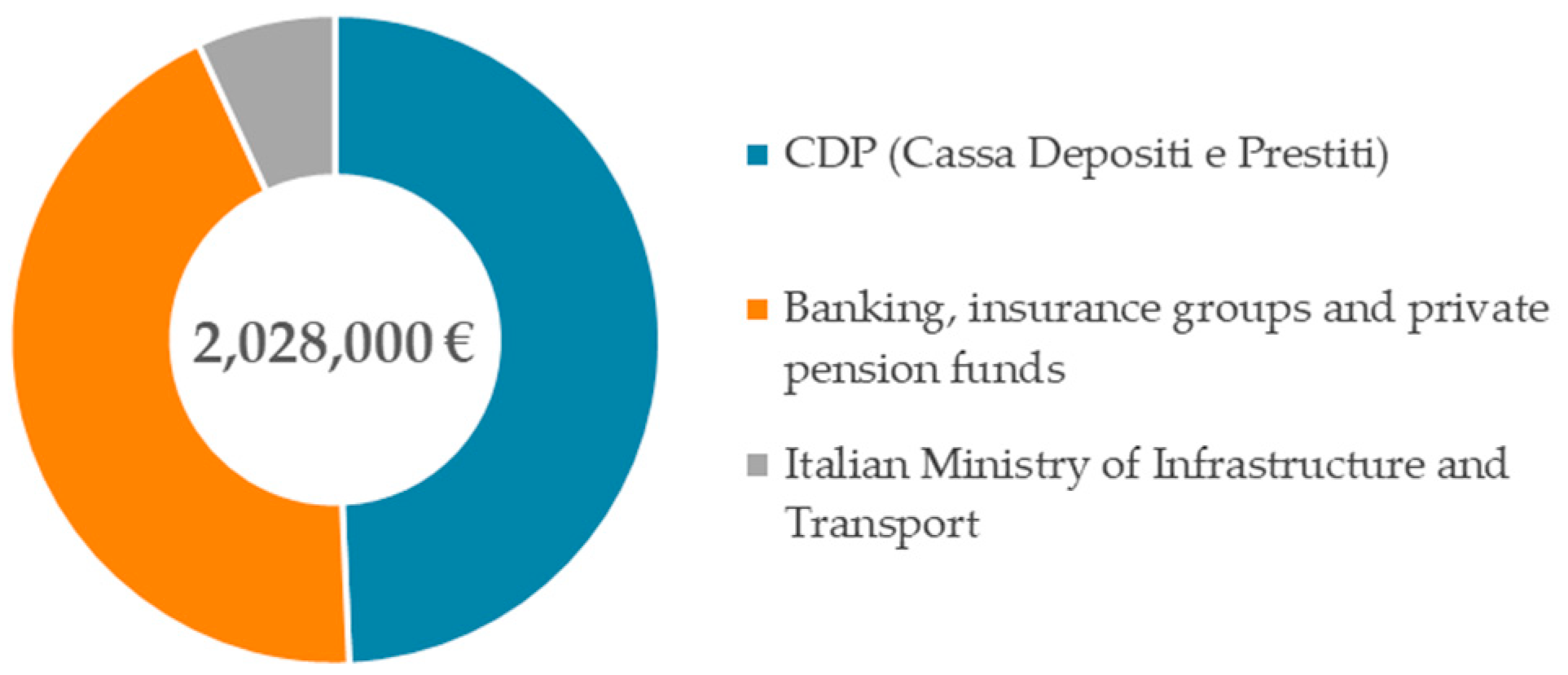
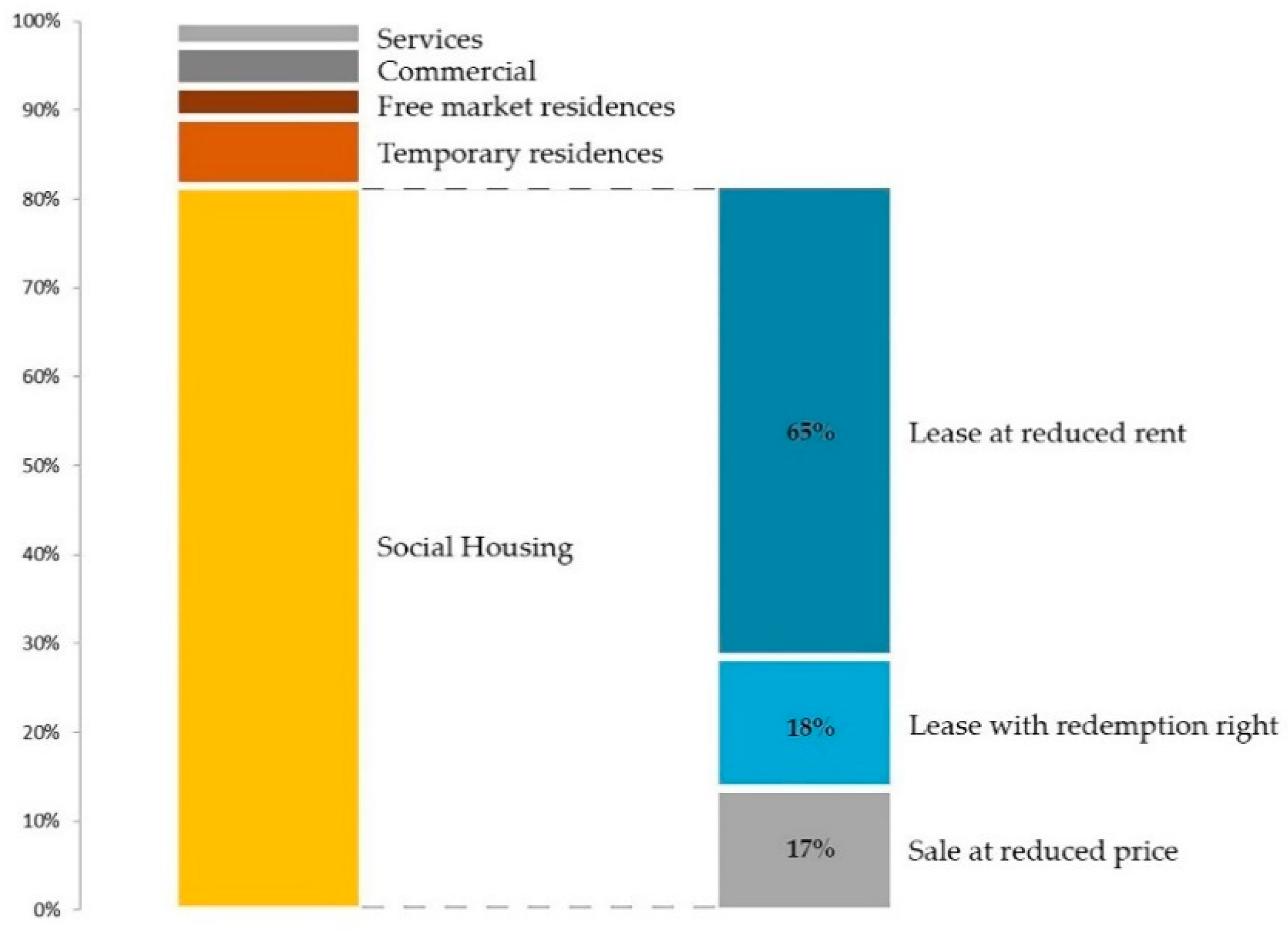
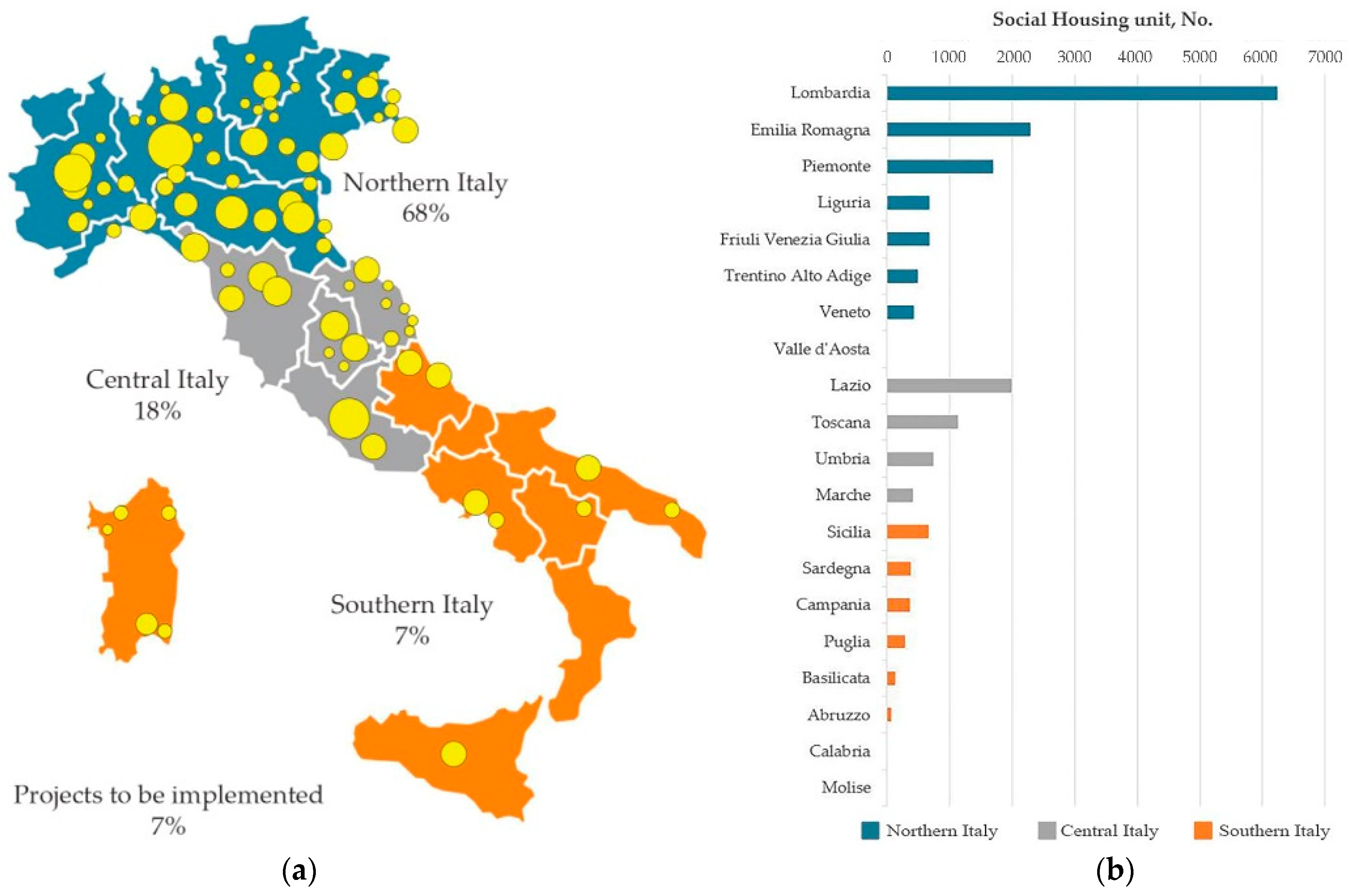

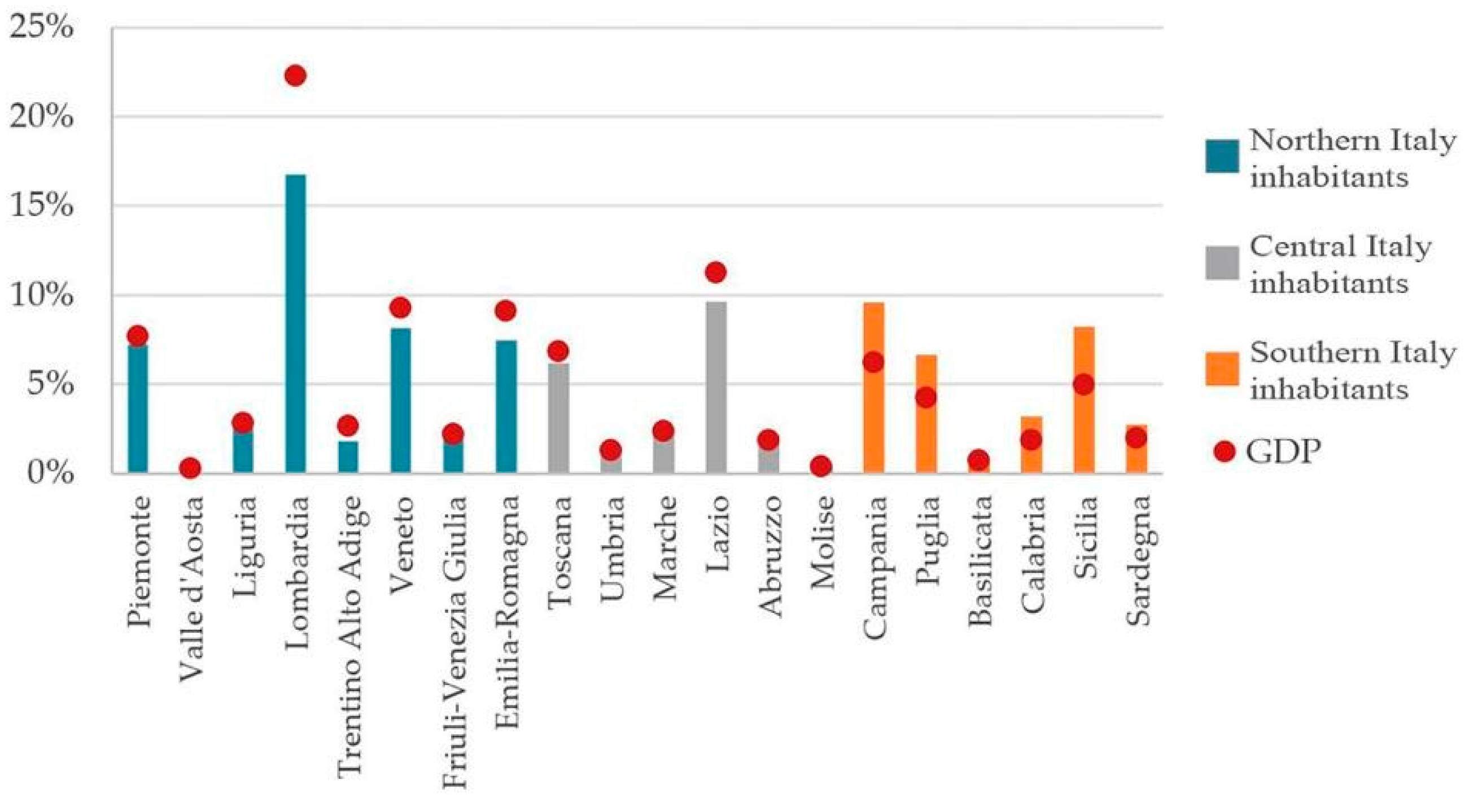
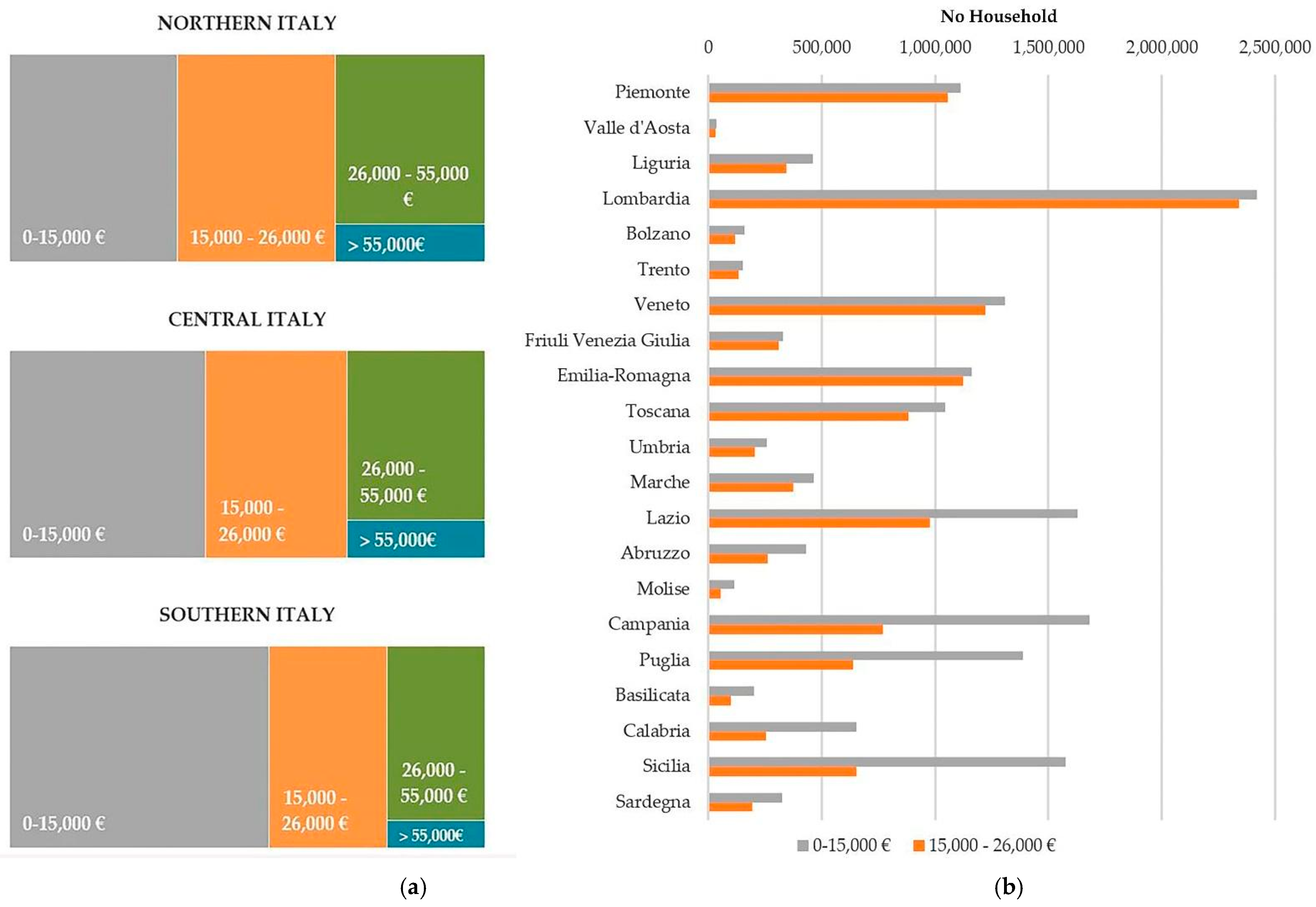

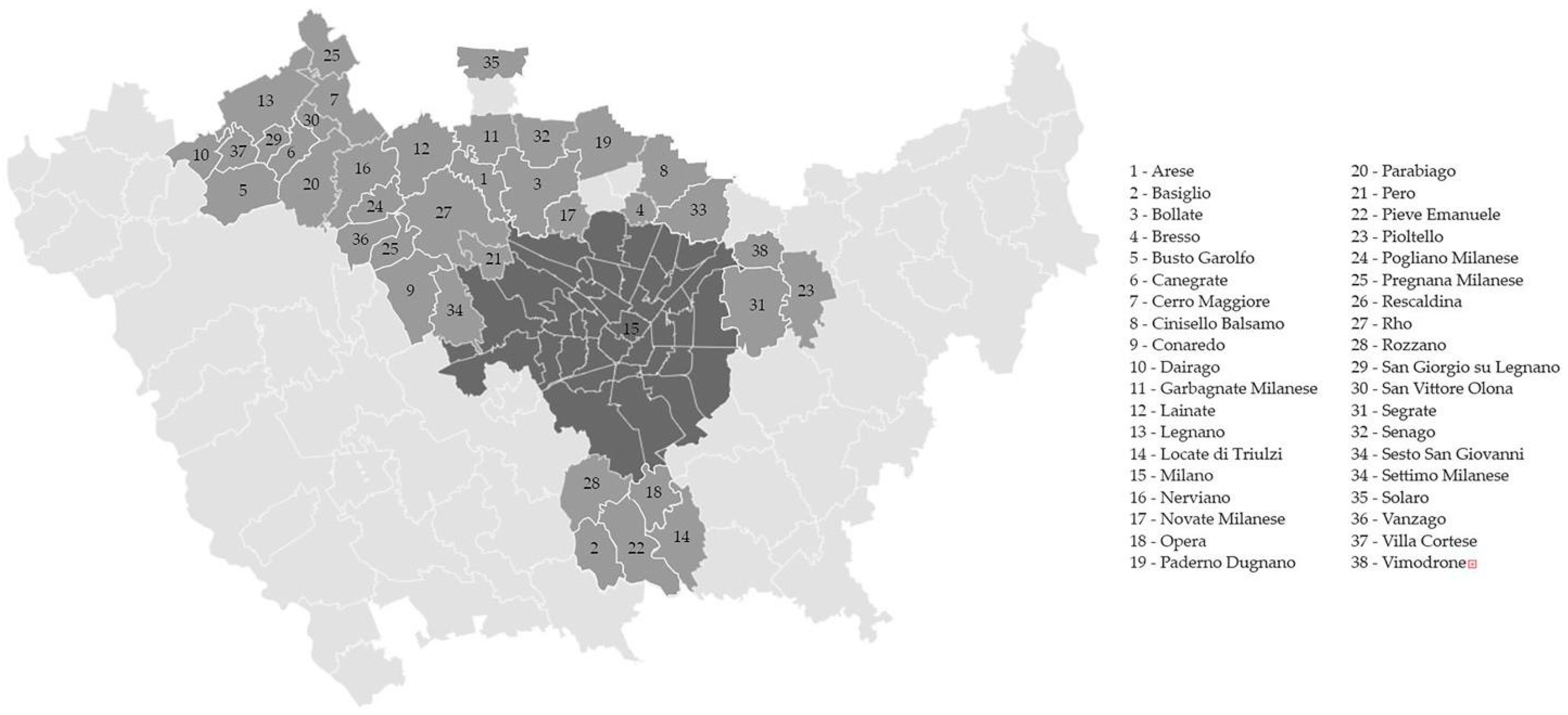
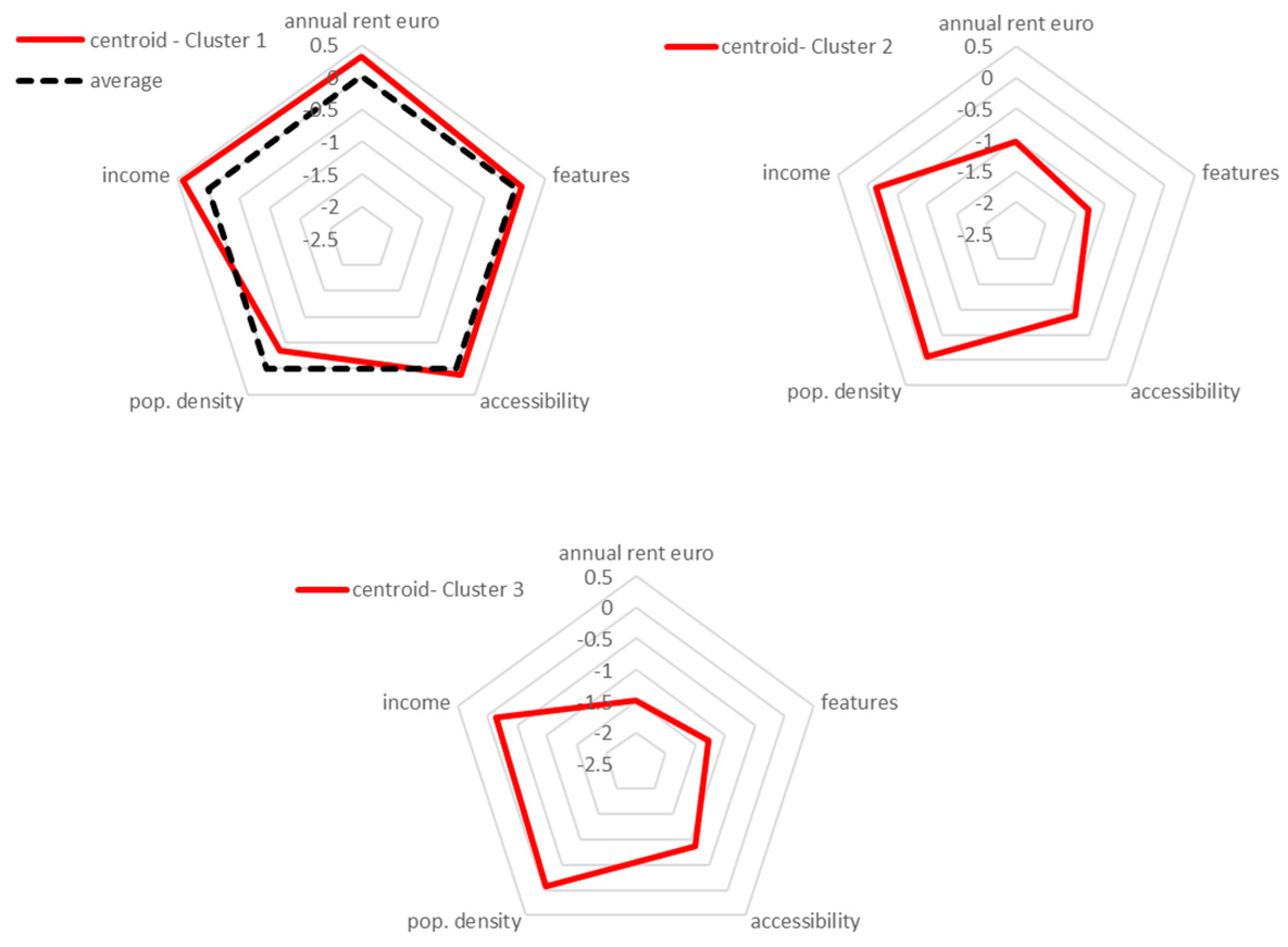
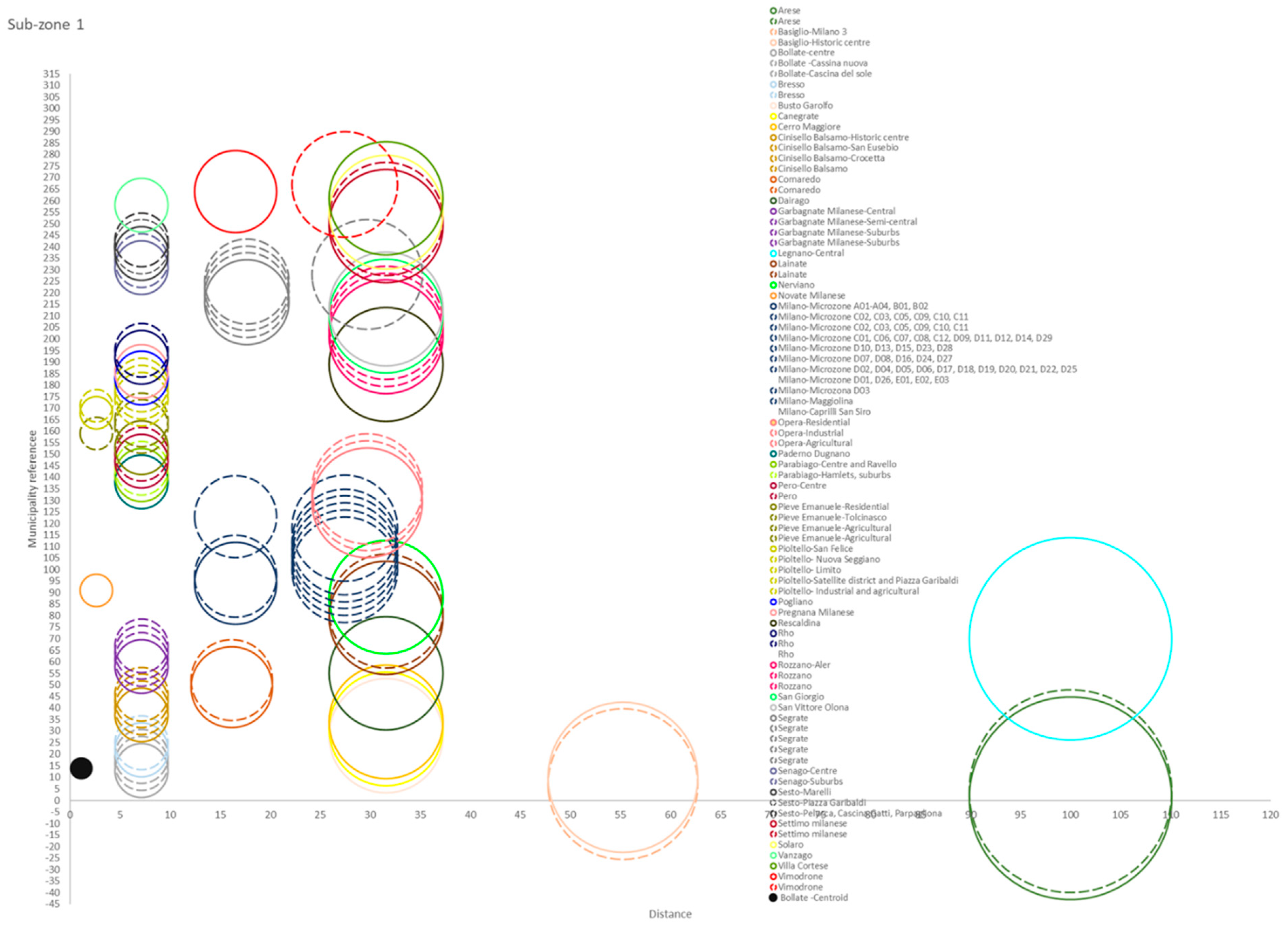
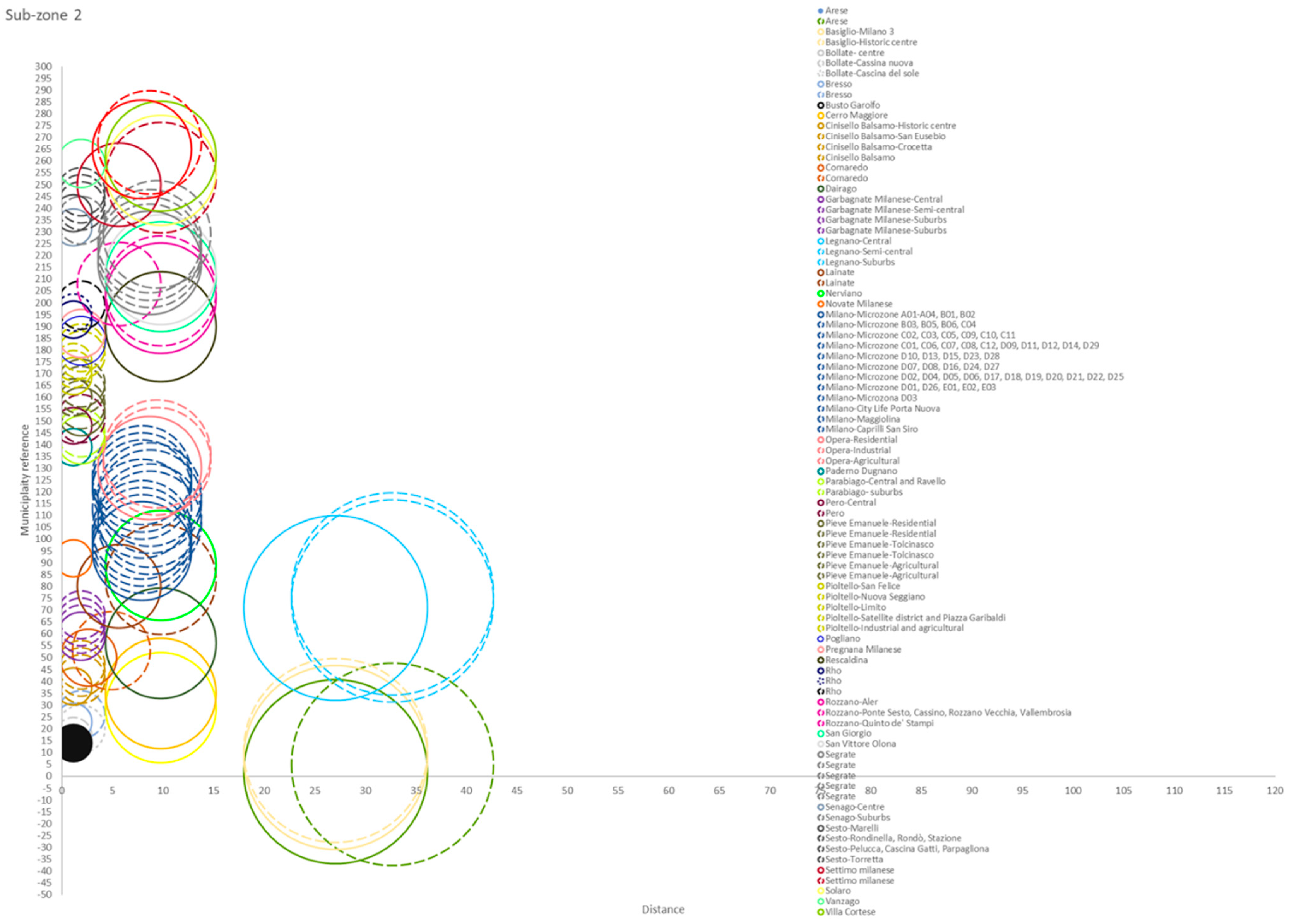
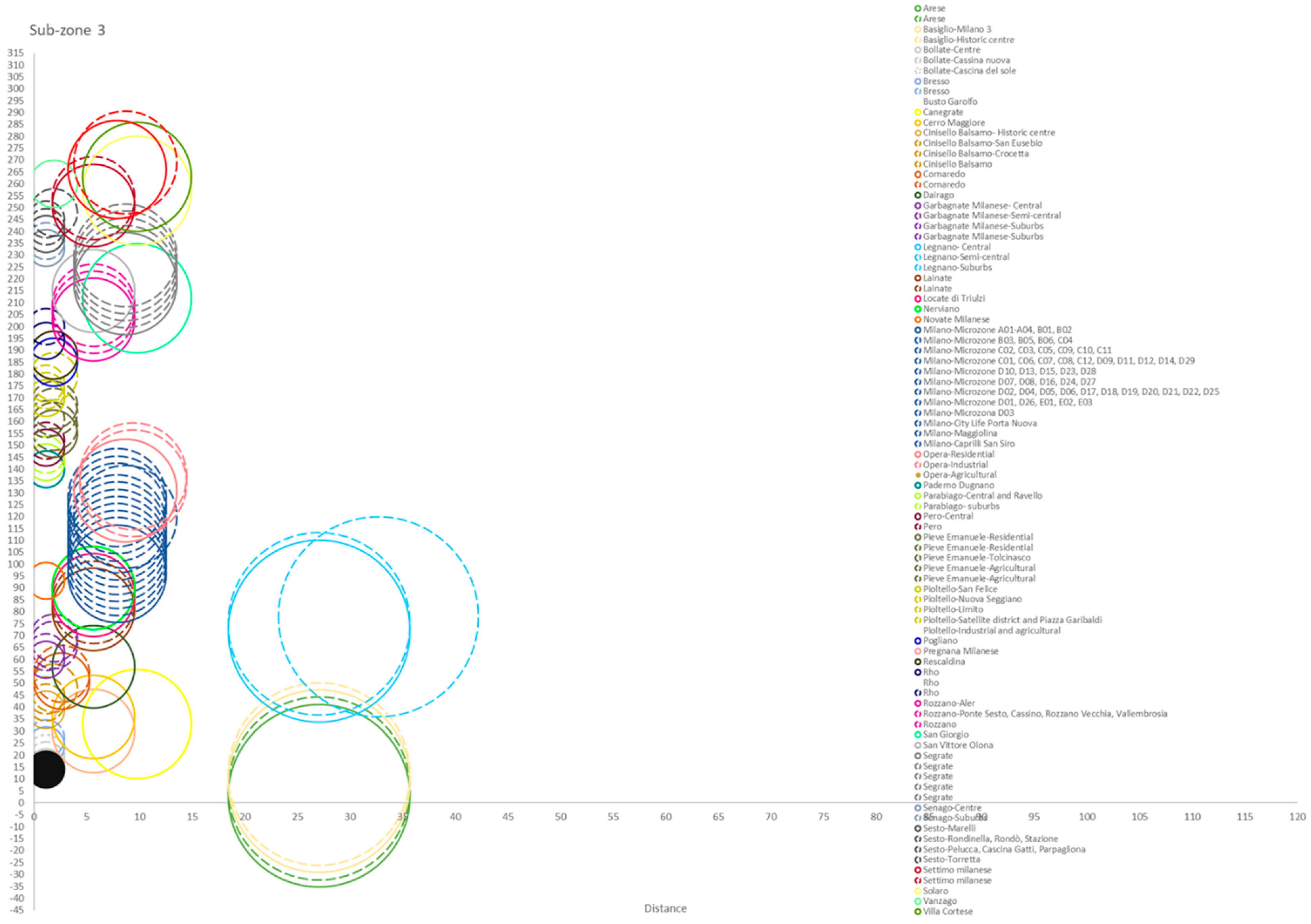

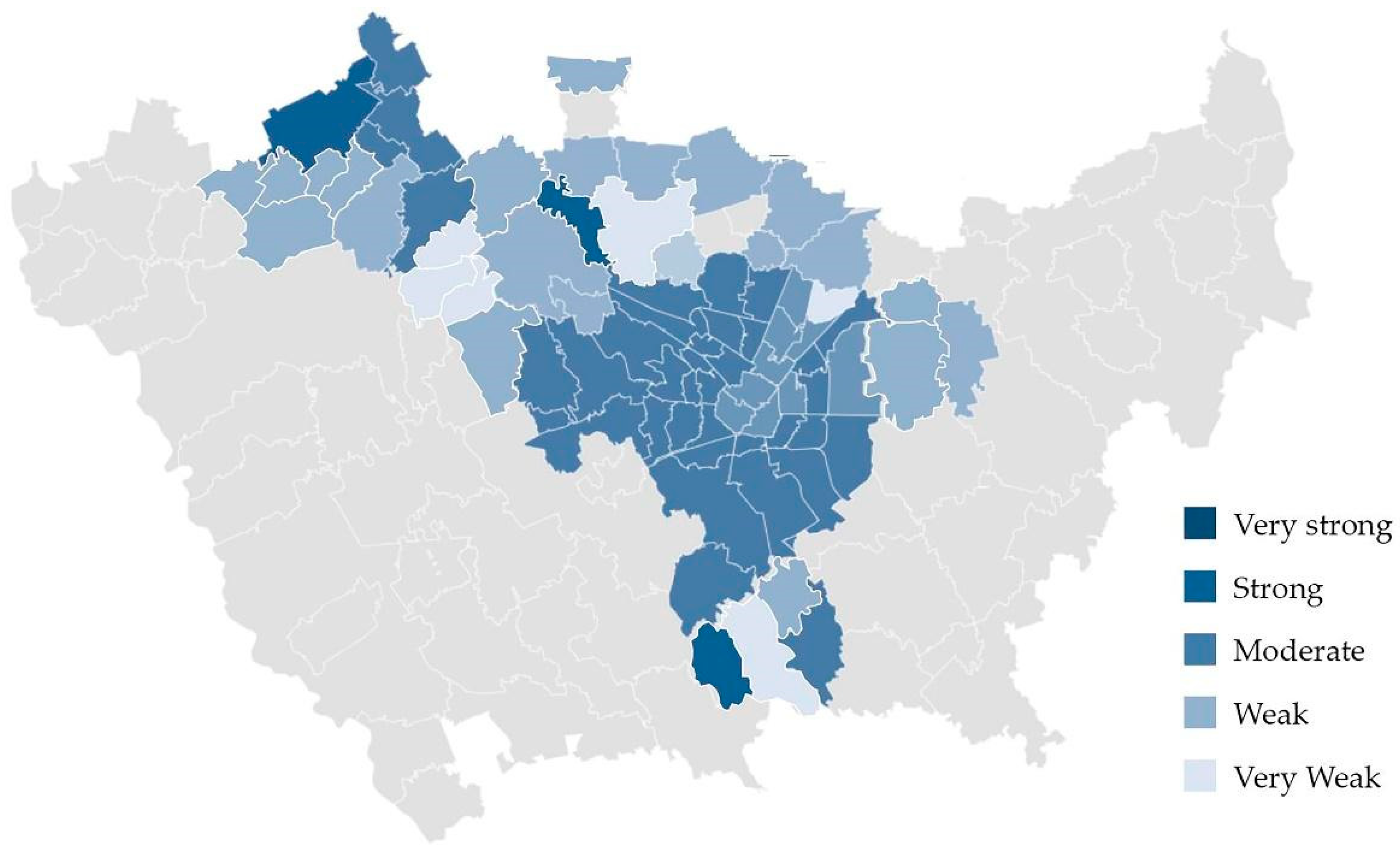
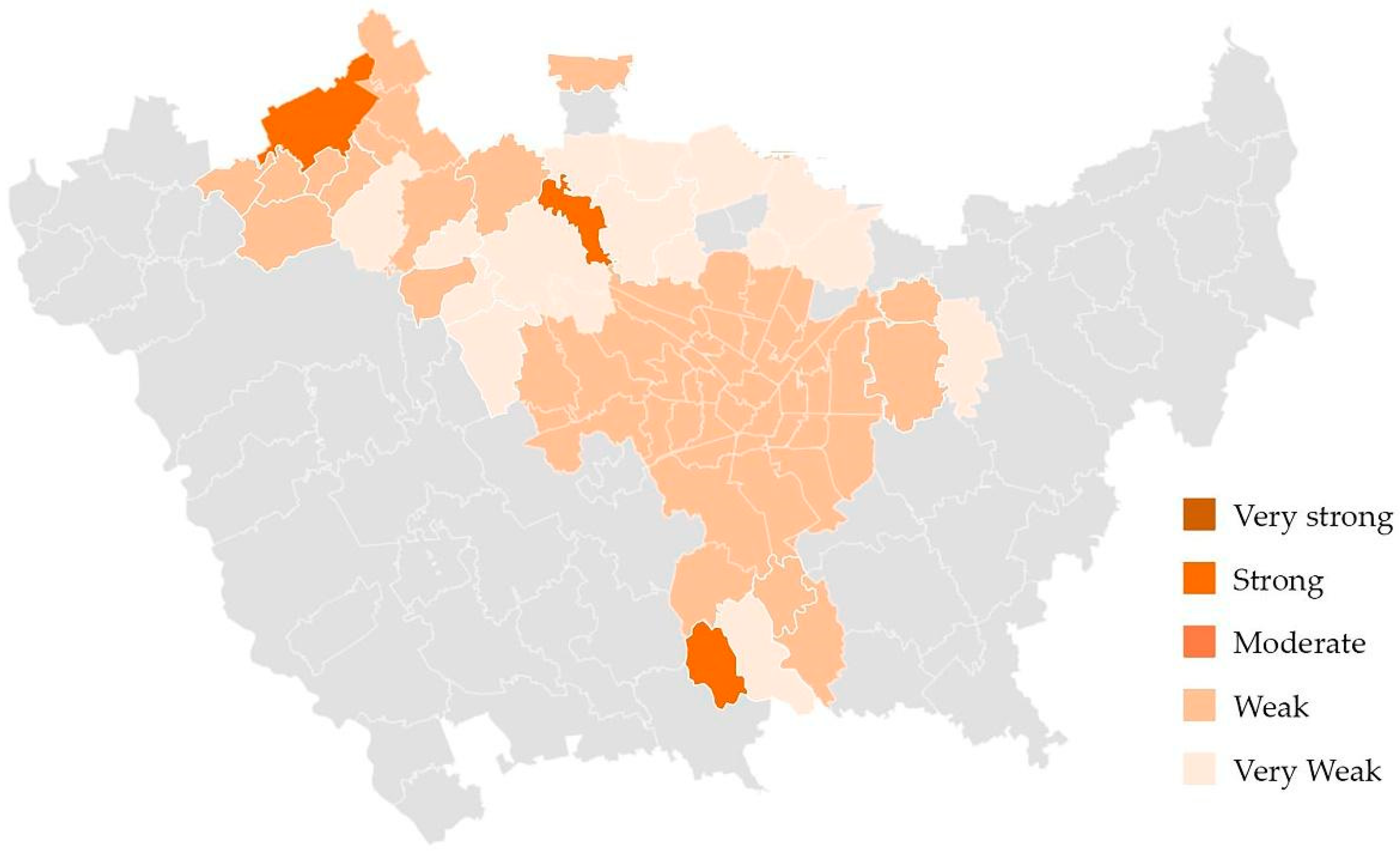
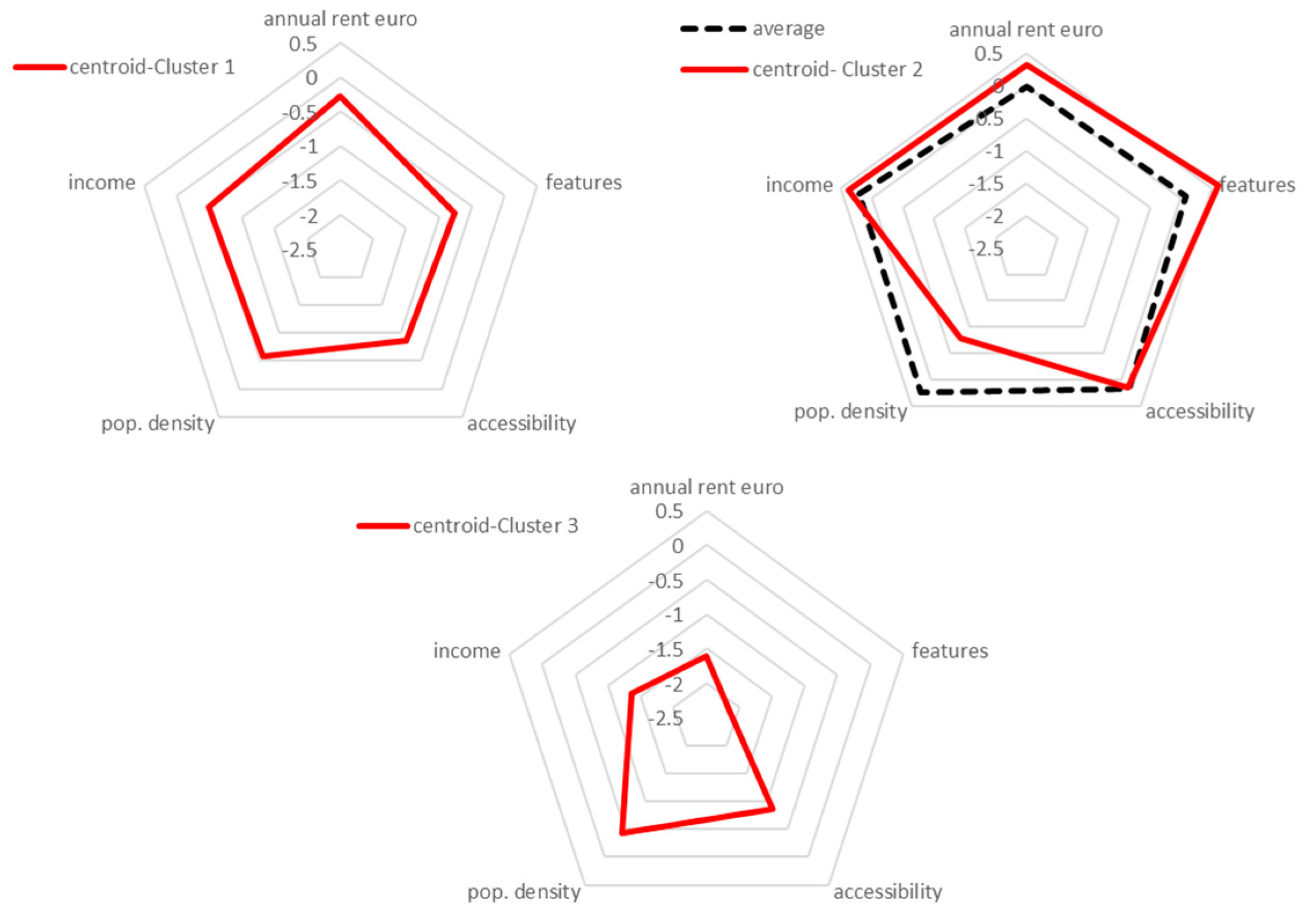
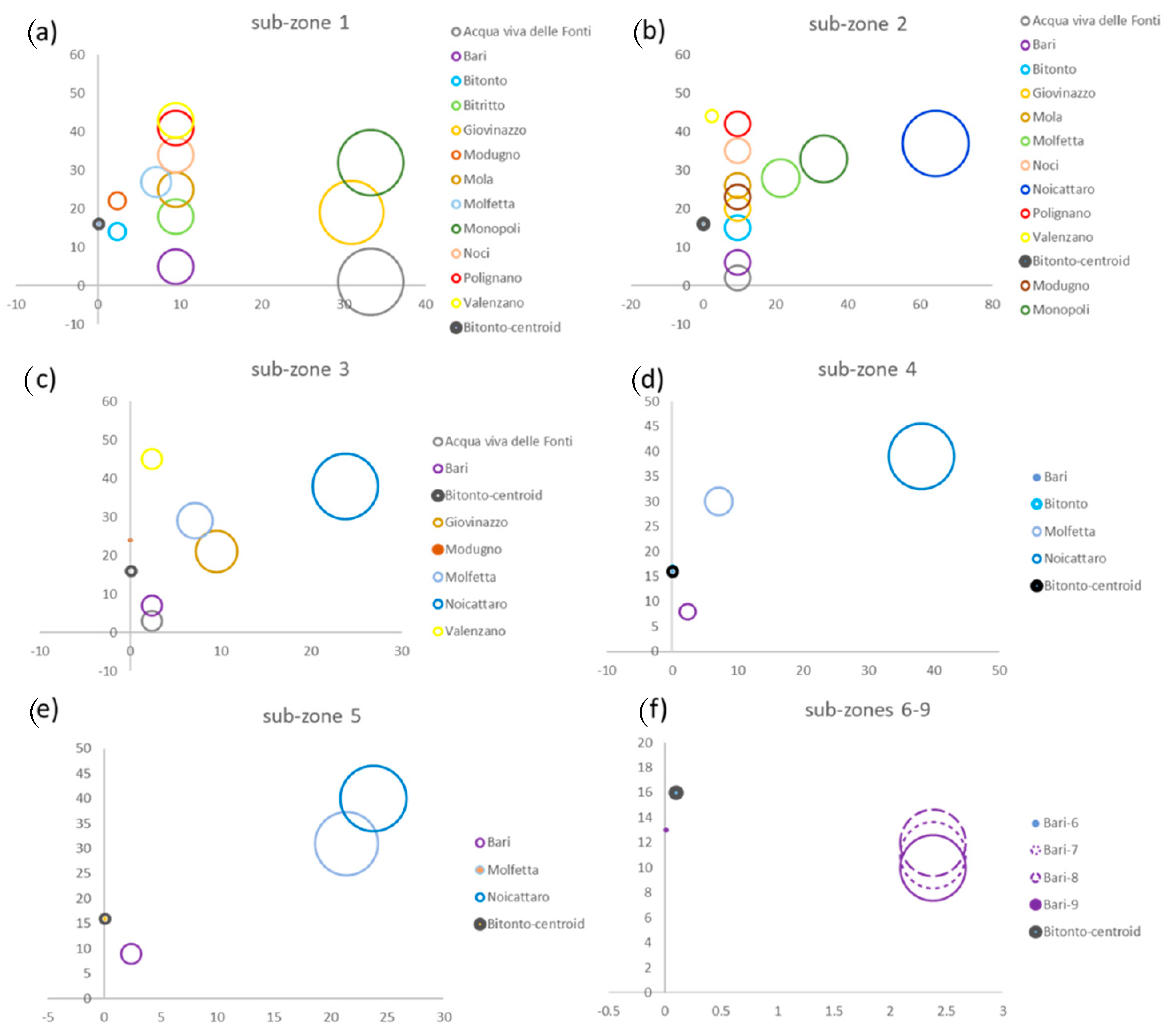
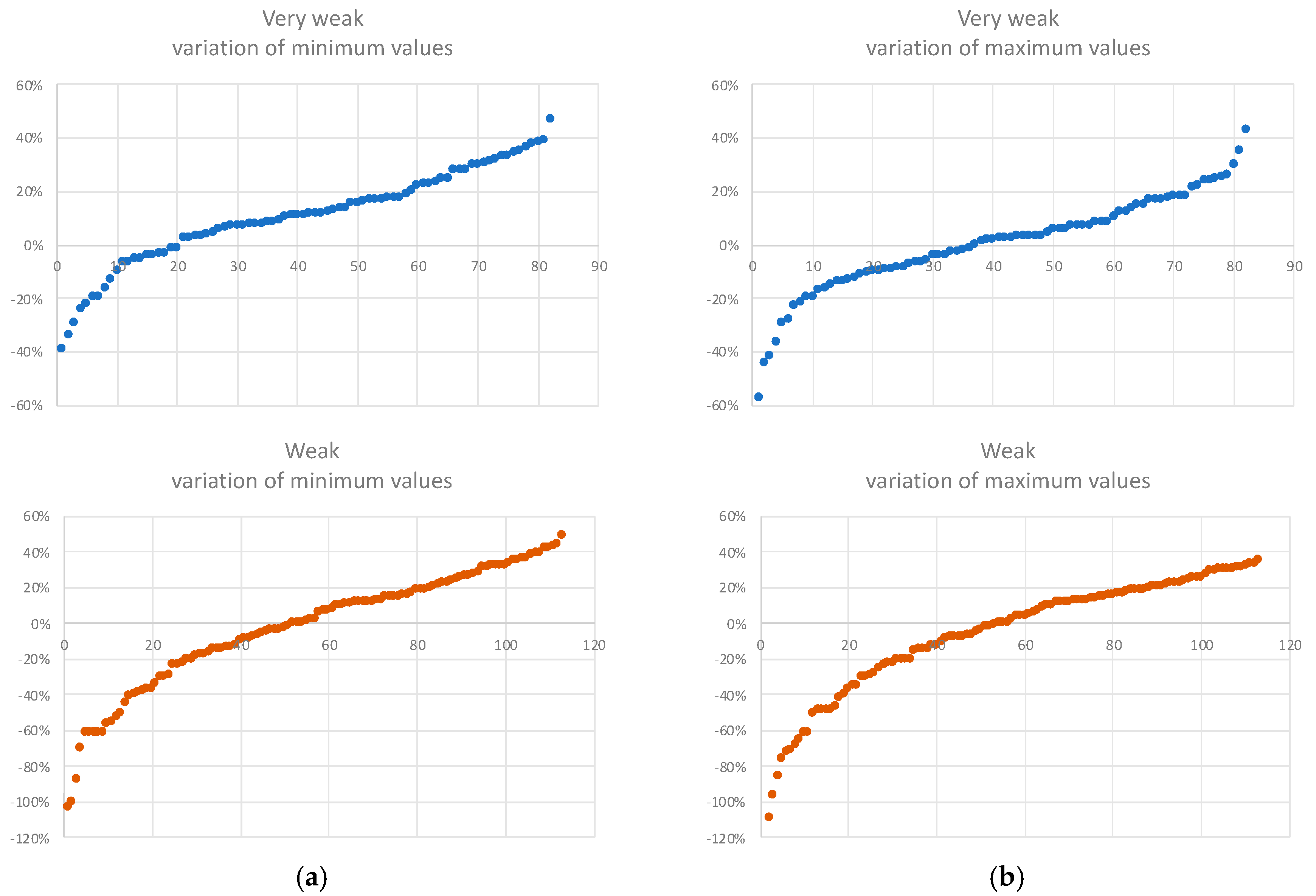
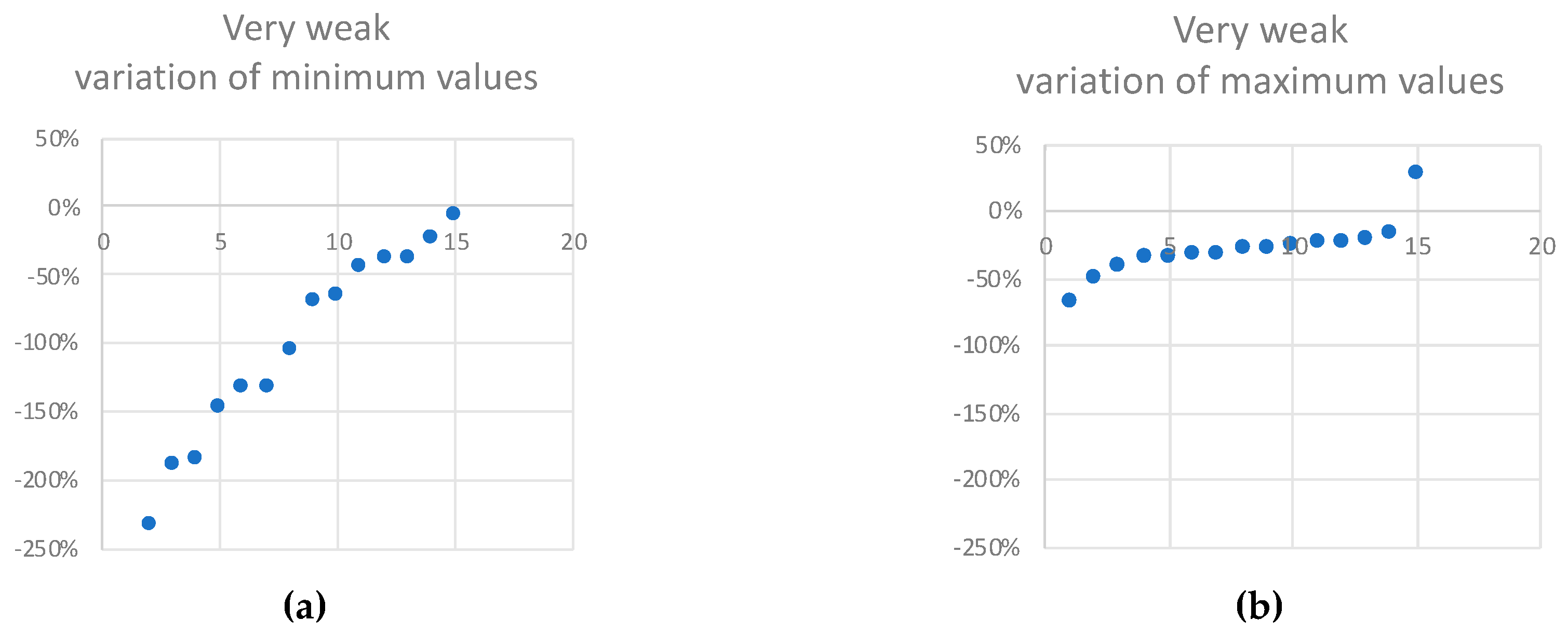
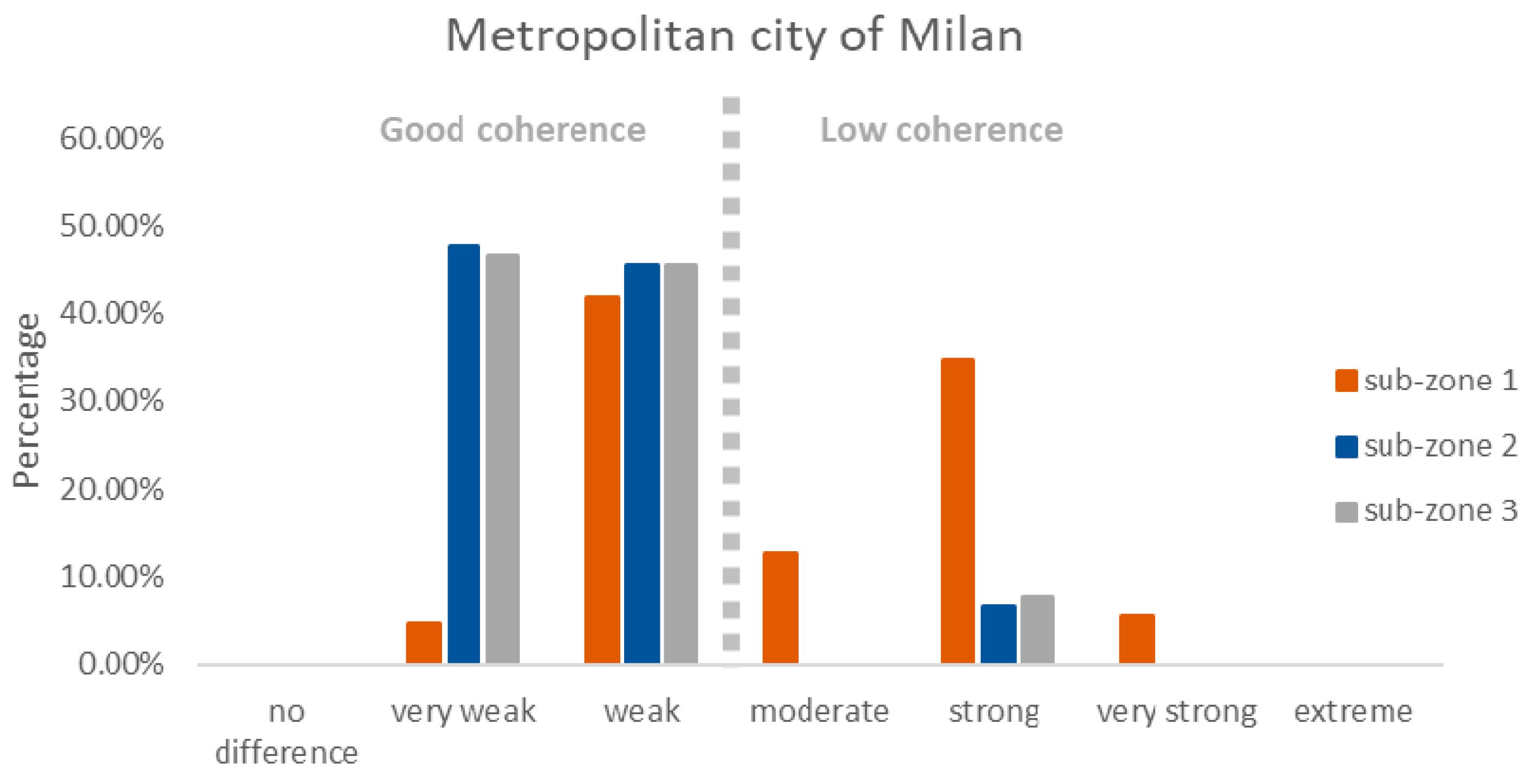
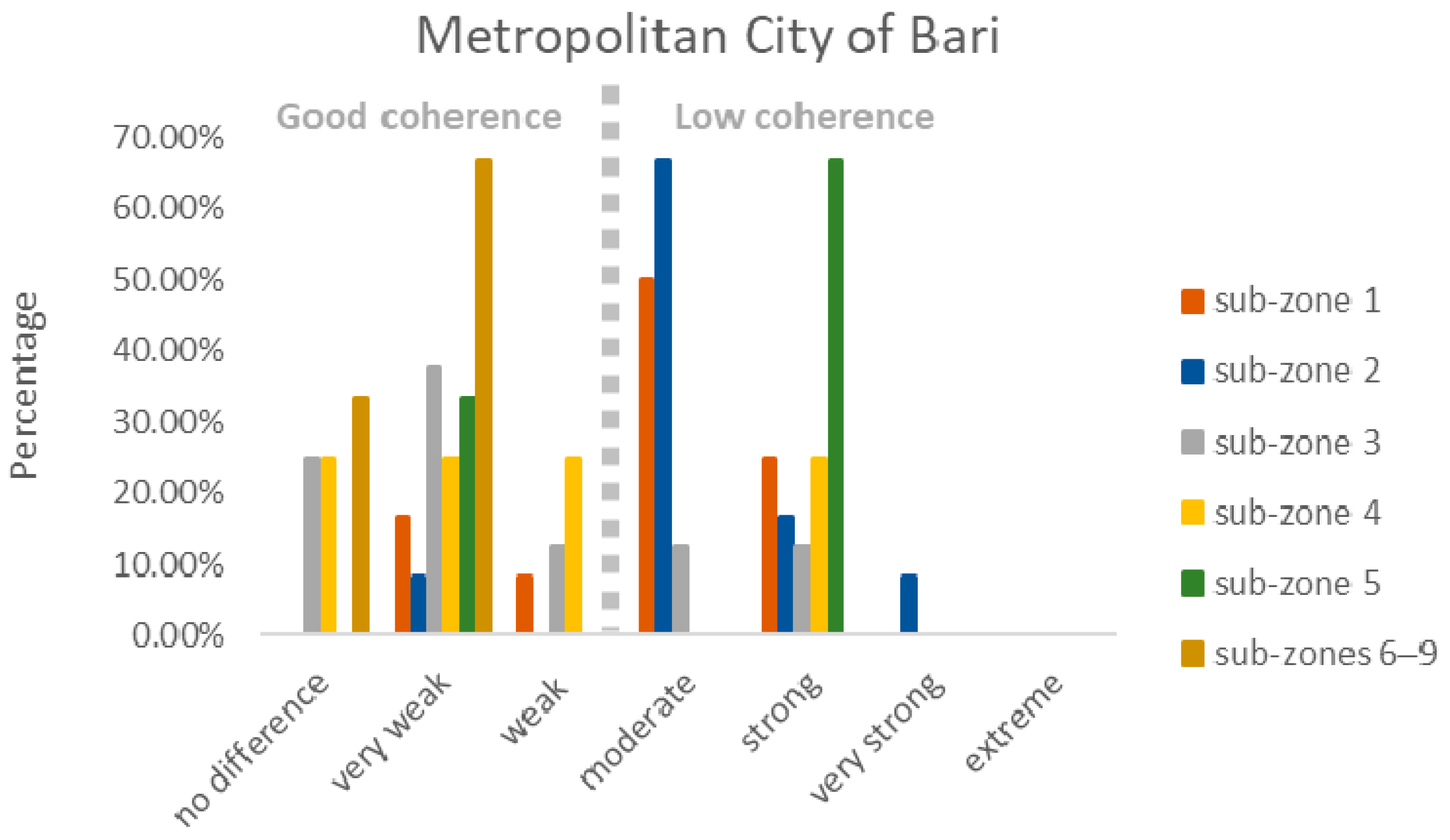
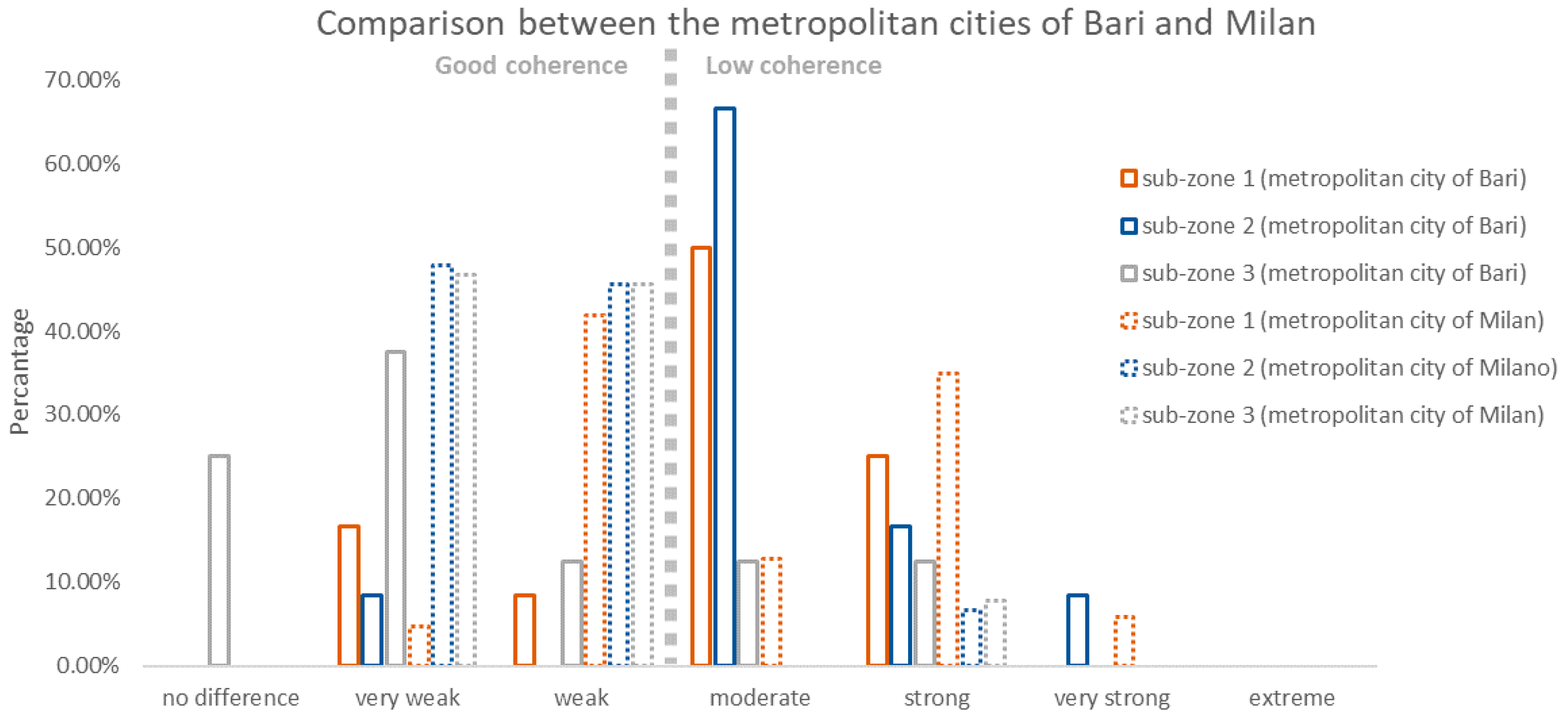
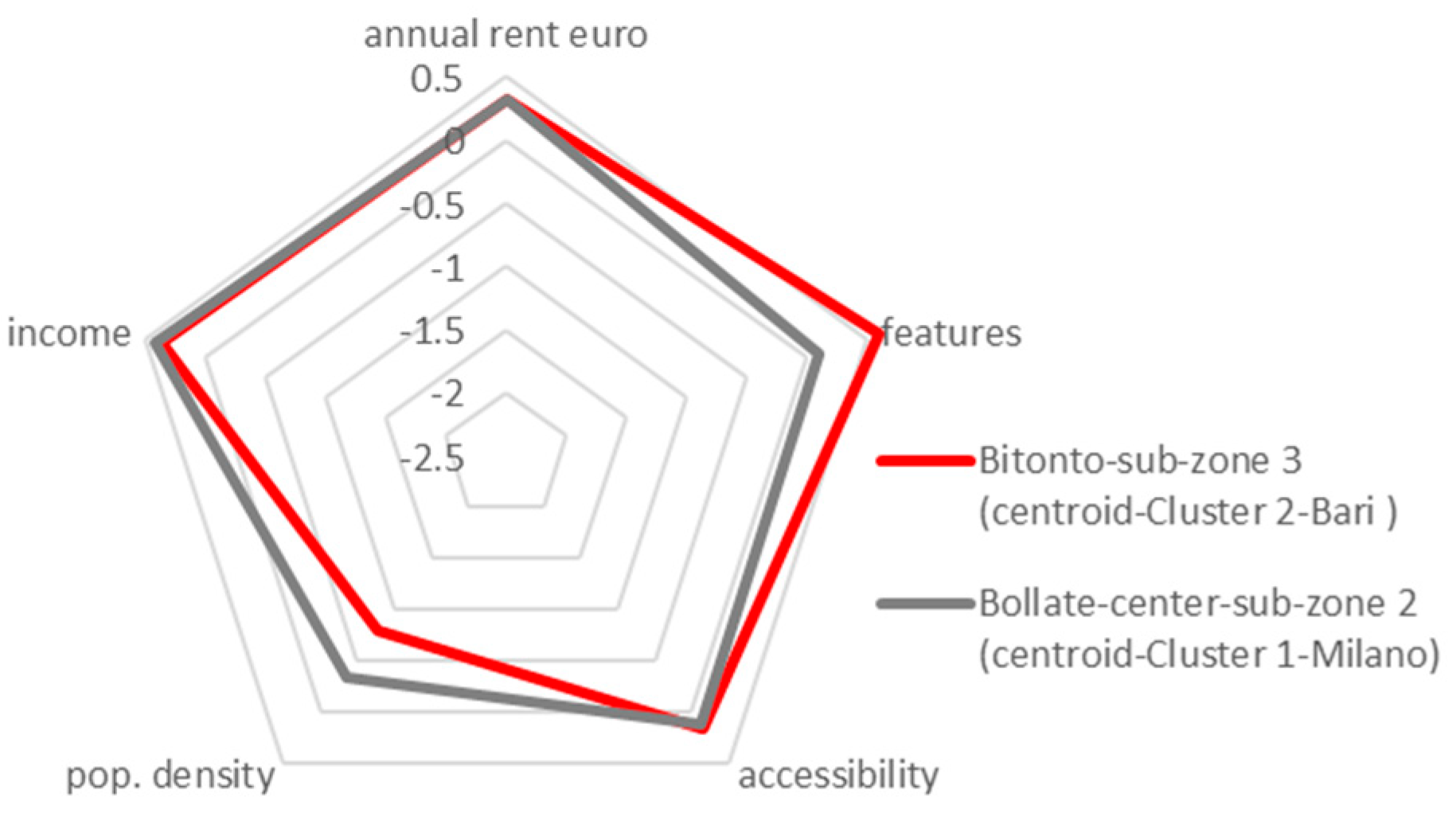
| City and Neighborhood | Household Income Thresholds | Housing Unit Size | Agreed Rents | Agreed Rent with Redemption Right | ||||
|---|---|---|---|---|---|---|---|---|
| Min | Max | Min | Max | Min | Max | |||
| €/year | €/year | Sq.m | Sq.m | €/year | €/year | €/sq.m year | €/sq.m year | |
| Bari—Santo Spirito | 7680 | 45,779 | 40 | 54 | 2560 | 3456 | 64 | 94 |
| 62 | 73 | 3968 | 4672 | |||||
| 75 | 91 | 4800 | 5824 | |||||
| Metropolitan City of Milan | Metropolitan City of Bari | |
|---|---|---|
| Geographic area | Northern Italy | Southern Italy |
| Region | Lombardia | Puglia |
| Capital city | Milan | Bari |
| Municipalities (No.) | 133 | 41 |
| Area (km2) | 1575.65 | 3825 |
| Percentage of regional area (%) | 6.60% | 19.57% |
| Area of the capital city (km2) | 181.67 | 116.17 |
| Inhabitants (No.) | 3,250,077 | 1,234,997 |
| Percentage of regional inhabitants (%) | 30.08 | 32.19 |
| Inhabitants of the capital city (No.) | 1,395,980 | 316,491 |
| Pro-capite GDP * (€/year) | 46,128 | 22,319 |
| Group | Subgroup | Characteristics |
|---|---|---|
| Type A | A1 | Internal bathroom completes with all elements (cup, sink, bathtub or shower) and with at least one window or mechanical ventilation device |
| A2 | Essential and functional technological systems: Drinking water supply; plant prepared for the installation of the water heater; electrical system; gas system | |
| Type B | B1 | Habitable kitchen with at least one window |
| B2 | Lift for living units located on the 2nd floor or upper floor | |
| B3 | Normal maintenance status of the building unit and for all its constituent elements: technological systems, fixtures, floors, walls, and ceilings | |
| B4 | Technological systems complying with the sanitary and safety regulations in force on the date of conclusion of the agreed rent | |
| B5 | Central heating or autonomous | |
| Type C | C1 | Double bathroom of which at least one complete with all the elements (cup; sink; bathtub or shower) and with at least one window or mechanical ventilation device |
| C2 | Garage or carport (exclusive or shared) | |
| C3 | Communal garden | |
| C4 | Good maintenance status of the real estate unit and for all its constituent elements: technological systems of the house, fixtures, floors, walls, and ceilings | |
| C5 | Normal maintenance status of the building and for all its constituent elements: common technological systems, facades, roofs, stairs, and internal common zones | |
| C6 | Armored doors and double glazing | |
| C7 | Proximity of the house to all services: Metro station, tram network, shops, and social services | |
| Type D | D1 | Presence of accessory elements: Balconies or terrace |
| D2 | Presence of functional elements: Cellar or attic | |
| D3 | Apartments with an age of less than 30 years, except for buildings of value, although not bound by law | |
| D4 | Absence of specific sources of environmental and noise pollution | |
| D5 | Exterior view of value | |
| D6 | Private garden or exclusive open space | |
| D7 | Uncovered parking space | |
| D8 | Apartments that in the last 10 years have been the subject of building intervention maintenance for which is required the declaration in the municipality of the beginning of activity (SCIA—Signaling Certified Beginning Activity) | |
| D9 | Terrace of more than 20 square meters |
| Municipality | Sub-Zone | Minimum Annual Rent | Minimum Real Estate Features | Accessibility | Pop. Density | €15,000 < pop. Income < €26,000 |
|---|---|---|---|---|---|---|
| €/sq.m | Score | Score | Inhab./sq.km | % | ||
| Arese | 1 | 60.00 | 1 | 3 | 3000.46 | 26.54% |
| 2 | 68.00 | 5 | 3 | 3000.46 | 26.54% | |
| 3 | 75.00 | 8 | 3 | 3000.46 | 26.54% | |
| 1 | 54.00 | 1 | 3 | 3000.46 | 26.54% | |
| 2 | 62.00 | 5 | 3 | 3000.46 | 26.54% | |
| 3 | 68.00 | 8 | 3 | 3000.46 | 26.54% | |
| Basiglio | 1 | 90.00 | 1 | 2 | 3000.46 | 17.75% |
| 2 | 96.00 | 5 | 2 | 952.18 | 17.75% | |
| 3 | 101.00 | 8 | 2 | 952.18 | 17.75% | |
| 1 | 65.00 | 1 | 2 | 952.18 | 17.75% | |
| 2 | 71.00 | 5 | 2 | 952.18 | 17.75% | |
| 3 | 79.00 | 8 | 2 | 952.18 | 17.75% | |
| Bollate | 1 | 60.00 | 1 | 4 | 2801.91 | 34.89% |
| Municipality | Sub-Zone | Minimum Annual Rent | Minimum Real Estate Features | Accessibility | Pop. Density | €15,000 < pop. Income < €26,000 |
|---|---|---|---|---|---|---|
| €/sq.m | Score | Score | Inhab./sq.km | % | ||
| Acqua viva Fonti | 1 | 21.00 | 3 | 3 | 155.17 | 28.53% |
| 2 | 19.20 | 5 | 3 | 155.17 | 28.53% | |
| 3 | 27.84 | 6 | 3 | 155.17 | 28.53% | |
| Bari | 1 | 21.00 | 3 | 5 | 2745.69 | 26.78% |
| 2 | 22.80 | 4 | 5 | 2745.69 | 26.78% | |
| 3 | 40.92 | 4 | 5 | 2745.69 | 26.78% | |
| 4 | 24.00 | 5 | 5 | 2745.69 | 26.78% | |
| 5 | 20.76 | 5 | 5 | 2745.69 | 26.78% | |
| 6 | 18.60 | 5 | 5 | 2745.69 | 26.78% | |
| 7 | 21.00 | 5 | 5 | 2745.69 | 26.78% | |
| 8 | 19.80 | 5 | 5 | 2745.69 | 26.78% | |
| 9 | 24.60 | 6 | 5 | 2745.69 | 26.78% |
Publisher’s Note: MDPI stays neutral with regard to jurisdictional claims in published maps and institutional affiliations. |
© 2022 by the authors. Licensee MDPI, Basel, Switzerland. This article is an open access article distributed under the terms and conditions of the Creative Commons Attribution (CC BY) license (https://creativecommons.org/licenses/by/4.0/).
Share and Cite
Napoli, G.; Trovato, M.R.; Barbaro, S. Social Housing and Affordable Rent: The Effectiveness of Legal Thresholds of Rents in Two Italian Metropolitan Cities. Sustainability 2022, 14, 7172. https://doi.org/10.3390/su14127172
Napoli G, Trovato MR, Barbaro S. Social Housing and Affordable Rent: The Effectiveness of Legal Thresholds of Rents in Two Italian Metropolitan Cities. Sustainability. 2022; 14(12):7172. https://doi.org/10.3390/su14127172
Chicago/Turabian StyleNapoli, Grazia, Maria Rosa Trovato, and Simona Barbaro. 2022. "Social Housing and Affordable Rent: The Effectiveness of Legal Thresholds of Rents in Two Italian Metropolitan Cities" Sustainability 14, no. 12: 7172. https://doi.org/10.3390/su14127172
APA StyleNapoli, G., Trovato, M. R., & Barbaro, S. (2022). Social Housing and Affordable Rent: The Effectiveness of Legal Thresholds of Rents in Two Italian Metropolitan Cities. Sustainability, 14(12), 7172. https://doi.org/10.3390/su14127172







